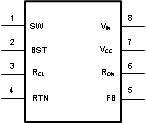JAJSBG5H September 2003 – November 2018 LM5007
PRODUCTION DATA.
- 1 特長
- 2 アプリケーション
- 3 概要
- 4 改訂履歴
- 5 Pin Configuration and Functions
- 6 Specifications
- 7 Detailed Description
-
8 Application and Implementation
- 8.1 Application Information
- 8.2
Typical Application
- 8.2.1 Design Requirements
- 8.2.2
Detailed Design Procedure
- 8.2.2.1 Custom Design With WEBENCH® Tools
- 8.2.2.2 Custom Design With Excel Quickstart Tool
- 8.2.2.3 Feedback Resistors, RFB1 and RFB2
- 8.2.2.4 Switching Frequency Selection, RON
- 8.2.2.5 Buck Inductor, L1
- 8.2.2.6 Output Capacitor, COUT
- 8.2.2.7 Type I Ripple Circuit, RC
- 8.2.2.8 Input Capacitor, CIN
- 8.2.2.9 Current Limit, RCL
- 8.2.3 Application Curves
- 9 Power Supply Recommendations
- 10Layout
- 11デバイスおよびドキュメントのサポート
- 12メカニカル、パッケージ、および注文情報
パッケージ・オプション
メカニカル・データ(パッケージ|ピン)
サーマルパッド・メカニカル・データ
発注情報
5 Pin Configuration and Functions
DGK Package and NGT Package
8-Pin VSSOP and 8-Pin WSON
Top View
